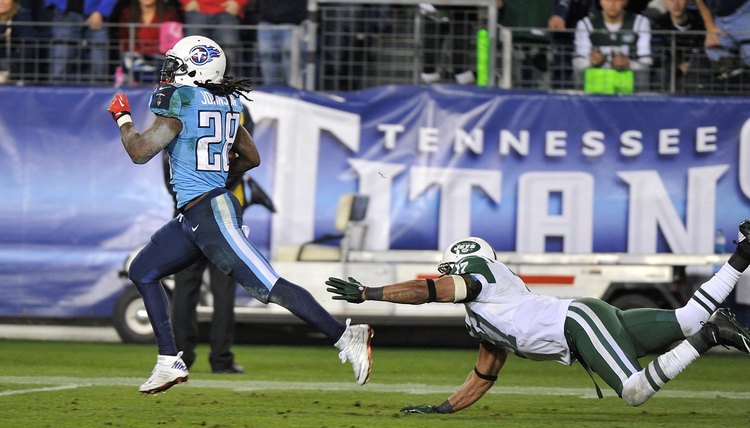A Workout Schedule for a Running Back

If you want to be a top running back at any level -- high school, college, the National Football League -- be prepared to work out on a year-round basis. Chris Johnson of the Tennessee Titans is one of the fastest players in the game. A former track star, he made it to the pros largely because of a fierce work ethic that enabled him to raise his grades to qualify for Division I college football, and then get even faster as a professional athlete by working on core strength and stride length. "Where I'm from, there are a lot of dudes with talent who didn't make it," Johnson told the STACK website. "So, I always knew that working hard was one of the most important things."
Types of Workouts
As Sports Fitness Advisor explains, a workout schedule for a running back, or any other football player, includes a pre-season phase, in-season phase and transition phase. The hardest work is done during the off-season phase. Depending on the running back position you play and your style, you'll want to individualize your workouts. A speed back such as Johnson needs to emphasize speed and agility. A workhorse fullback needs to emphasize power.
Pre-Season Workouts
In terms of power and strength, you'll be starting with functional strength training by lifting weights during the off-season, then cycling into maximum strength training with heavier weights for optimal muscle development and finally working on explosive power and sport specific exercises. Sports Fitness Advisor says speed and agility work becomes a more prominent part of your workouts later in the off-season, utilizing extensive interval training -- all-out sprints alternating with slower "rest" periods of running. Flexibility drills are particularly important for all football players, particularly running backs, since an optimal range of motion improves your speed, agility and even power. Former star Herschel Walker's off-season weekly routine included six days of 85-minute workouts. Walker lifted weights targeted at different areas of the body on separate days, and did several days of cardio and plyometrics work each week.
In-Season Workouts
The goal of in-season workouts is to maintain all of the gains you've made during the off-season and peak each week for the game. You training schedule is strictly game-related. You need to fully recover from a game before a hard workout and rest or lower the intensity of your workouts as game day approaches. Weight training sessions usually are reduced, and you'll do fewer reps and sets during those sessions.
Transition Phase
Since your body is likely to be beaten up at the end of the season, a transition phase lasting four to six weeks is essential. "If you don't take time to rest -- physically and mentally -- you will burnout," says Sports Fitness Advisor. Many players enjoy other recreational sports, such as golf or basketball or hunting, during the off-season. Keeping active and doing something you enjoy will refresh your body and spirit for the beginning of off-season workouts and the long build up to the next season.
Considerations
Top running backs individualize their workouts in a number of ways. Although Chris Johnson and Ray Rice, star of the 2012 Super Bowl champion Baltimore Ravens, both incorporate lots of plyometrics -- jumping, leaping and bounding exercises to develop explosive speed and power -- into their off-season workouts, Rice likes working out on a beach in New York City. As STACK explains, Rice's trainer has devised a routine with a variety of forward, reverse, and lateral jumps and hops to simulate the running back's movements during a game. Sprinting on the beach also is a workout staple for Rice. Running on sand increases the intensity of a workout while decreasing the impact on the joints.
References
Writer Bio
Jim Thomas has been a freelance writer since 1978. He wrote a book about professional golfers and has written magazine articles about sports, politics, legal issues, travel and business for national and Northwest publications. He received a Juris Doctor from Duke Law School and a Bachelor of Science in political science from Whitman College.
